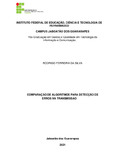| dc.relation | HAYKIN, S. Sistemas de Comunicação: Analógicos e Digitais, 4 ed. São Paulo:
Bookman, 2004.
MOON, T. K. Error Correction Coding: Mathematical Methods and Algorithms.
New Jersey, USA: WILEY, 2005.
MORELOS-ZARAGOZA, R. H. The Art of Error Correcting Coding. Chichester,
England: John Wiley & Sons, 2002.
PROAKIS, J. G.; SALEHI, M.; BAUCH, G. Contemporary Communication Systems
using Matlab and Simulink. 2a ed. New Jersey, USA: Bookware Company, 2006.
SKLAR, B. Digital Communications, Fundamentals and Applications. New
Jersey,USA: Prentice Hall, 1993.
MOREIRA, J. C.; FARREL, P. G. Essentials of Error-Control Coding. West Sussex,
England: WILEY, 2006.
TANNER, L. M. A recursive approach to low complexity codes. IEEE Trans. Inf.
Theory, vol. 27, no. 5, pp. 533–547, 1981.
TANG, H.; XU, J.; KOU, Y.; LIN, S. and Abdel-Ghaffar, K.; On algebraic construction
of Gallager and circulant low-density parity-check codes. IEEE Trans. Inf. Theory,
vol. 50, no. 6, pp. 1269–1279, June 2004.
KOU, Y.; LIN, S.; FOSSORIER, M. Low-density parity-check codes based on finite
geometries: A rediscovery and new results. IEEE Trans. Inf. Theory, vol. 47, pp.
2711–2736, November 2001.
AMMAR, B.; HONARY, B.; KOU, Y.; XU, J.; LIN, S. Construction of low-density
parity check codes based on balanced incomplete block designs. IEEE Trans.
Inf. Theory, vol. 50, no. 6, pp. 1257–1269, June 2004.
ARNONE, L.; GAYOSO, C.; GONZALEZ, C.; CASTIÑEIRA, J. A LDPC logarithmic
decoder implementation. Proc. VIII International Symposium on Communications Theory and Applications, St. Martin’s College, Ambleside, United Kingdom, pp. 356–
361, July 2005.
NAYAGAM, A. LDPC toolkit for Matlab, disponível em http://arun-
10.tripod.com/ldpc/generate.html, Maio 2002.
BRINK, S. T., KRAMER, G.; ASHIKHMIN, A. Design of low-density parity-check
codes for modulation and detection. IEEE Trans. Commun., vol. 52, no. 4, pp. 670–
678, April 2004.
HAGENHAUER, J.; OFFER, E.; PAPKE, L. Iterative decoding of binary block and
convolutional codes. IEEE Trans. Inf. Theory, vol. 42, no. 2, pp. 429–445, March
1996.
LIN, S.; COSTELLO, D. Error Control Coding: Fundamentals and Applications.
New Jersey, USA: Prentice-Hall, 1983.
ELIAS, P.; Error-Free Coding. IRE Trans., vol. PGIT-4, pp. 29-37, 1954.
WOZENCRAFT, J. M.; JACOBS, I. M. Principles of Communication Engineering.
New York: John Wiley & Sons, 1965.
MASSEY, J. L. Threshold Decoding. Cambridge, MA: MIT Press, 1963.
FANO, R. M. A Heuristic Discussion of Probabilistic Decoding. IEEE Transactions
on Information Theory, IT-9, pp. 64-74, April 1963.
JELINEK, F. A Fast Sequential Decoding Algorithm Using a Stack. IBM Journal of
Research and Development, Vol. 13, pp. 675-685, November 1969.
OKUMURA, J. K. On the Viterbi Decoding Algorithm. IEEE Transaction on
Information Theory, Vol. IT-15, pp. 177-179, January, 1979.
BERROU, C.; GLAVIEUX, A; THITIMAJSHIMA, P. Near Shannon Limit Error-
Correcting Coding and Decoding: Turbo-Codes. Proc. I993 IEEE Int. Con$ Coinm.
(ICC‘93), pp. 1064-1070, Geneve, Switzerland, May 1993.
WICKER, S. B.; Error Control Systems for Digital Communication and Storage.
Prentice Hall, 1995.
VITERBI, A. J.; OMURA, J. K. Principles of Digital Communication and Coding.
New York, USA: McGraw-Hill, 1979.
VITERBI, A. J. Error Bounds for Convolutional Codes and an Asymptotically
Optimum Decoding Algorithm. IEEE Trans. Information Theory, vol. 13, pp. 260-
269, Apr. 1967.
VUCETIC, B. Iterative Decoding Algorithms. Invited paper, The International
Symposium on Personal, Indoor and Mobile Radio Communications, PIMRC’97, Sept.
1-4, Helsink, Finland, 1997.
HAGENAUER, J.; HOEBER, P. A Viterbi algorithm with soft-decision outputs and
its applications. Proc. Globecom’89, pp.1680-1686, Nov. 1989.
LI, Y.; VUCETIC, B. A Generalized MLSE Algorithm. INNSP’95, China, December
10-13, 1995.
LI, Y.; VUCETIC, B.; SATO, Y. Optimun soft-output detection for channels with
inter-symbol interference. IEEE Trans. Inform. Theory, Vol-41, No. 3, May 1995, pp.
704-713.
VUCETIC, B.; YUAN, J. Turbo Codes: Principles and Applications.
Massachussetts, USA: Kluwer Academic Publishers, 2000. | pt_BR |


